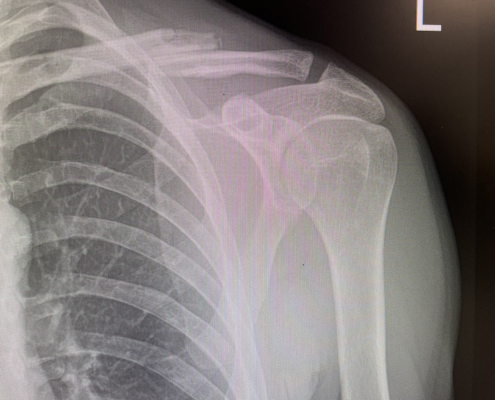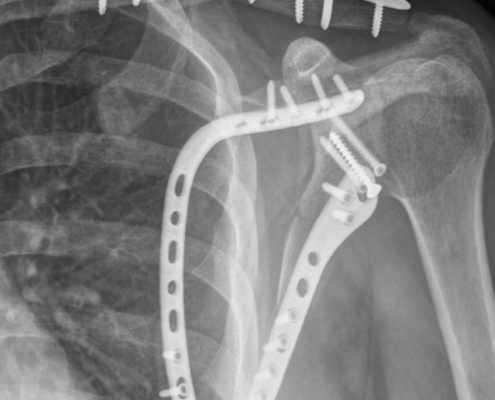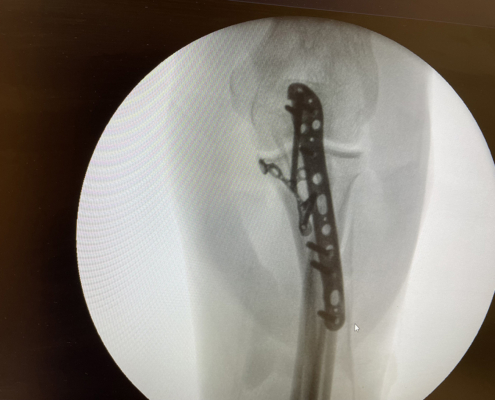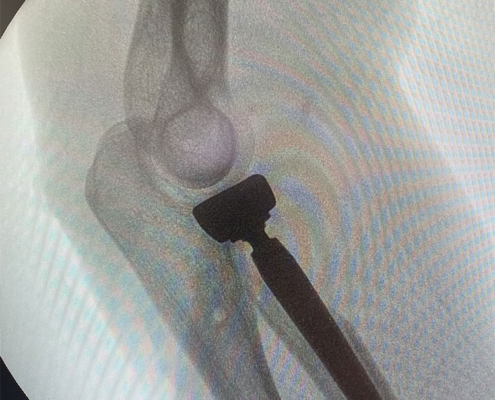Shoulder and Elbow Fracture Surgery London
Anatomy
The shoulder is a ball-and-socket joint with the greatest range of motion of all the body’s joints. It consists of three bones:
- the clavicle, or collarbone
- the scapula, or shoulder blade
- the proximal humerus, which is the rounded uppermost part of the arm bone
- These bones intersect to form two joints in the shoulder
3-D CT Reconstruction of Shoulder area showing Clavicle, Scapula , Proximal Humerus and the Acromio Clavicular (A C/ Collar bone joint) & the Glenohumeral (Ball & Socket) joint.
Injury
- A fracture can occur in any of the bones in the joint
- Muscles, tendons, and ligaments surround and stabilize the joint and help prevent the bones from moving out of place
- These may also be injured when a fracture occurs
Symptoms
Symptoms vary depending on the specific type of fracture but may include:
- Pain
- Swelling and bruising
- Inability to move the shoulder
- A grinding sensation when the shoulder is moved
- Deformity — “It does not look right.”
- Occasionally bleeding (open fracture)
- Loss of normal use of the arm if a nerve injury occurs
A fracture may be classified as
Closed
the broken bone remains beneath the skin
Open
a fragment of bone breaks through the skin
Displaced
bones are separated into two or more pieces that don’t remain in contact with each other
Non displaced
when the pieces of the broken bone don’t separate and the bone fragments remain in place
Different fractures that can happen
Clavicle Fracture
- The clavicle, also called the collarbone, is a long bone that connects the shoulder blade to the breastplate, or sternum
- A broken collarbone is the most common type of shoulder fracture
- Symptoms include a sharp pain at the site of injury, swelling, and bruising
- The patient may find it difficult to move the arm and the movement may cause a painful grinding sensation where the ends of the broken bone rub against each other
- A broken collarbone may also cause the shoulder to sag downward, and a bump may be visible beneath the skin where the bone has fractured
- If the fracture is caused by a high-impact injury such as a car accident, the bone may stick through the skin, which is referred to as an open fracture
Radiographs showing Clavicle fracture and Plating
Scapula Fracture
- The scapula, or shoulder blade, is a large, flat, triangular bone on the back that connects the humerus, or upper arm bone, and the clavicle, or collarbone
- The shoulder blade is well protected by surrounding muscles and doesn’t break easily, but a high-energy, direct impact—as might result from a car or motorcycle accident—can cause the bone to fracture into two or more pieces
- Symptoms include significant, sharp shoulder pain when the injured attempts to move the arm, as well as swelling, bruising, and tenderness in the skin over the injury
- Shoulder blade fractures are rarely open fractures, and they may not require surgery to heal
Radiographs showing fixation of Scapula and Clavicle Fractures
Proximal Humerus Fracture
- The proximal humerus is the rounded upper part of the arm bone that rotates within the shoulder socket
- This bone may fracture because of an impact from a fall or car accident, or as a result of a shoulder dislocation, in which the humerus is forced out of the joint socket
- Symptoms include severe pain, limited motion in the shoulder, swelling, tenderness, and a cracking or popping sound, called crepitus, when the patient attempts to move the arm
- This type of shoulder fracture is more common in people with osteoporosis, a condition that causes bones to become weak and brittle and increases the risk of any type of fracture
Radiographs Showing Proximal Humerus Fracture and Plating
Elbow Fractures
Anatomy
- The elbow is a hinge joint that allows the movement of the forearm—which extends between the elbow and the wrist—back and forth, as well as rotate the palm to face up or down
- The elbow connects the upper arm, or humerus, to the radius and ulna, the bones that make up the forearm
- A fracture may occur in one or more of the bones that form the elbow
- An injury to the elbow may also pull the bones of the joint out of place, compromising the stability and range of motion of the joint called a fracture dislocation
Different fractures that can happen
Olecranon Fracture
- The olecranon is an extension of the ulna, one of the two bones in the forearm
- When the arm is bent, it forms the point at the tip of the elbow
- The olecranon is not covered by any muscles or ligaments, so it’s especially vulnerable to fracture if the elbow makes direct contact with a hard surface
- Most commonly it happens as a result of a strong, sudden contraction of the triceps muscle, located above the elbow, during a fall
- The muscle contraction, called an eccentric contraction, is sometimes so strong that the force overwhelms the olecranon, resulting in a break in the bone
- Symptoms include sharp pain, an inability to extend the elbow, swelling, and tenderness
- The broken bone may also cause a visible protrusion beneath the skin
CT scan showing elbow ( complex Olecranon) fracture and Fixation
Radial Head Fracture
- The radial head is the part of the radius bone in the forearm that meets the humerus within the elbow joint
- A radial head fracture may occur if you put your hand out to break a fall
- The force of impact may travel through the radius and push the radial head into the bottom of the humerus with such force that it fractures
- Dislocating the elbow, a type of injury in which the bones of the joint become separated, can put stress on the radial head and lead to a fracture
- Symptoms include pain when the elbow is extended, swelling, and difficulty in rotating the forearm
- For example, turning the palm up or down may be painful
Radiographs showing Radial Head Replacement following complex Radial Head Fracture
Distal Humerus Fracture
- The distal humerus is the rounded bottom part of the bone that connects the elbow to the shoulder
- In the elbow, it rotates against the radial head and ulna, forming the upper part of the joint
- Fractures of the distal humerus are relatively uncommon, but may occur as the result of a hard blow to the elbow, falling directly onto a bent elbow, or putting out your hand to break a fall while the elbow is extended straight
- Symptoms include intense pain, tenderness, and swelling in and above the elbow
- You may not be able to extend the elbow, or the joint may feel weak or unstable, especially if you attempt to pick up an object or put weight on the affected arm
Radiographs showing Distal Humerus Fracture treated with fixation
Diagnosis
-
Shoulder and elbow fractures require immediate care in order to heal and prevent permanent damage to the bone or surrounding soft tissues. In case of an injury it is recommended to get medical attention immediately.


















